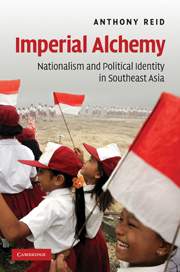Book contents
- Frontmatter
- Contents
- List of maps
- List of figures
- List of tables
- Acknowledgements
- Abbreviations
- 1 Nationalism and Asia
- 2 Understanding Southeast Asian nationalisms
- 3 Chinese as a Southeast Asian ‘other’
- 4 Malay (Melayu) and its descendants: multiple meanings of a porous category
- 5 Aceh: memories of monarchy
- 6 Sumatran Bataks: from statelessness to Indonesian diaspora
- 7 Lateforming ethnie in Malaysia: Kadazan or Dusun
- 8 Imperial alchemy–revolutionary dreams
- Glossary
- References
- Index
7 - Lateforming ethnie in Malaysia: Kadazan or Dusun
Published online by Cambridge University Press: 01 April 2010
- Frontmatter
- Contents
- List of maps
- List of figures
- List of tables
- Acknowledgements
- Abbreviations
- 1 Nationalism and Asia
- 2 Understanding Southeast Asian nationalisms
- 3 Chinese as a Southeast Asian ‘other’
- 4 Malay (Melayu) and its descendants: multiple meanings of a porous category
- 5 Aceh: memories of monarchy
- 6 Sumatran Bataks: from statelessness to Indonesian diaspora
- 7 Lateforming ethnie in Malaysia: Kadazan or Dusun
- 8 Imperial alchemy–revolutionary dreams
- Glossary
- References
- Index
Summary
At the end of 1995 the Malaysian government agreed that a fifth language could be taught in its schools, after Malay, Chinese and Tamil (long conceded to the three major communities in West Malaysia), and Iban (the largest of the Dayak languages of Sarawak, conceded shortly before). This language was called Kadazandusun, the latest mouthful to try to gain consensus among the indigenous peoples of Sabah (the northern corner of Borneo). At the last (2000) census the half a million people whose language this was or aspired to be were also listed as Kadazandusun. Going back through previous censuses, however, these were registered as two peoples, ‘Kadazan’ (104,924) and ‘Dusun’ (216,910) in 1991, merged into the larger Pribumi (indigenous people) category in 1980, all listed as Kadazans in 1970, and all as Dusuns in 1960 and previous censuses (seetable 7.1). I will refer to them as KD in this chapter.
Given the importance we have attached to censuses in the toolkit of identity creation, these differences suggest a troubled path to ethnie formation. By contrast with the Batak counterpart in the previous chapter, Sabah represents a case of even later politicisation and ethnie formation, well after the nation-state it was asked to join in 1963 had taken shape. Whereas Bataks had an equal share with other ethnie in building anti-imperial nationalism and its state nationalist successor, the Kadazandusun remain outside and in tension with the Malay ethno-nationalism which has the central place in Malaysia's state nationalist project.
- Type
- Chapter
- Information
- Imperial AlchemyNationalism and Political Identity in Southeast Asia, pp. 187 - 209Publisher: Cambridge University PressPrint publication year: 2009



